A Methodological Framework for Bridge Surveillance
Abstract
:1. Introduction
- 3 international tunnels (25.4 km), 566 tunnels (516 km), 1718 bridges and viaducts (681 km) along the tool highway;
- Approximately 1200 tunnels and 11,000 bridges and viaducts along the network managed by ANAS (motorways and state roads);
- Approximately 30,000 bridges, viaducts, and tunnels along the road managed by the provinces.
- Circular of the Ministry of Public Works of 19 July 1967 No. 6736/61/AI [3], in which the importance of an assiduous, agile, and systematic surveillance of the road asset is highlighted for the essential purposes of public safety, without excluding the economic aspects of the good conservation;
- Circular of the Ministry of Public Works No. 34233 of 25 February 1991-law No. 64 of 2 February 1974-art. 1 Ministerial Decree 4 May 1990 [4], instructions relating to the technical regulation of road bridges defining new technical standards for the design, execution, and testing of bridges were issued. In particular, for the existing bridges, it was proposed to manage the roads at various existing levels and to acquire full knowledge of the bridges’ current state ensuring the following fundamental topics: supervision, inspection, maintenance (ordinary and extraordinary), and static interventions (restoration, adaptation, and restructuring);
- Ministerial Decree of 17 January 2018, Update of the New Technical Standards for Construction (NTC2018) [5] and Ministerial Circular of 21 January 2019, Instructions for the application of the Update of the “Technical Standards for Construction” referred to in the Ministerial Decree of 17 January 2018 [6], where, related to all type of Existing Construction, the aspects concerning safety assessment, classification of interventions, and definition of the reference model for analysis are defined;
- Law Decree No. 109 of 28 September 2018, which contains urgent measures for the city of Genoa, the safety of the national infrastructure and transport network, the seismic events of 2016 and 2017, work and other emergencies [7]. Among the requirements law there was the creation of the National Information Archive of Public Structures (AINOP—Archivio Informativo delle Opere Pubbliche), listed in Art. 13 of the aforementioned decree;
- Guidelines for the Risk Classification and Management, Safety Assessment and Monitoring of Existing Bridges–Annexed to the opinion of the Superior Council of Public Works No. 88/2019 [8], referred as LG20 in the following, adopted through the Ministerial decree number 578 of 17 December 2020 [9]. These guidelines, defined by a commission of experts, aim to define and standardize the criteria for monitoring, assessing structural safety, and classifying the risk of existing bridges.
- Administrative data with regard to the managing corporation, roads location, relevance and use, costs incurred and to be incurred;
- Original design and maintenance process documents;
- Historical evolution of the constructions and the sites;
- Safety conditions and efficiency degree of the assets, including surveillance, monitoring, and instrumental checks data.
- The development of an asset catalogue consistent with the representations required by the standards (Geological and geothematic cartography developed by ISPRA [20], a BIM model of the public infrastructures according to Ministerial Decree 560/2017 of 1 December 2017 [21]—which actively implemented the statement of Article 23, Comma 13, of Legislative Decree No. 50 of 18 April 2016—also known as Codice degli Appalti) and with the regulations related to the hazards that the crossed territories are interested in: seismic (NTC2018), hydrogeological (Flood Risk Management Plan (PGRA), introduced by the Community Directive 2007/60/CE [22], which contains the management framework for the areas subject to risk identified in the districts and for the areas where there may be a significant potential floods hazard and where that may be generated in the future, as well as the coastal areas subject to erosion), and volcano;
- The creation of a multidisciplinary inspection model consistent with the ASPI manual [23] in use, with the results and the AINOP vision, and compatible with the studies and activities already in place for the LG20. In particular, maintaining the speed of the inspections, the model aims to integrate the state of deterioration recognition with a qualified analysis of the deterioration effects on the safety conditions and formal and scientific validation of the results;
- The training of young engineers to carry out inspection activities and maintenance process management;
- The support in the managing corporation’s management processes with risk analyses based on multidisciplinary approaches, also through further agreements with the corporations and other managers present in the area. In this context of infrastructural risk analysis and management, among the important initiatives supported by the CUGRI, the CUR_CIS2020 project was developed: “Methodologies for the punctual assessment of hydrogeological risk in highly anthropized areas and tools for regional development strategies”. Thanks to regional funding, this project saw the involvement of all Campanian universities and main infrastructure management corporations present in the regional “Strategic Infrastructure Corridor” (CIS), providing those “methodologies” of an interdisciplinary nature to be used in trans-disciplinary terms with the infrastructure management corporations [24].
2. The Methodological Framework Proposed for Bridge Surveillance
- Macro Group 1 (MG1): manholes with width up to 6 m, for which the ordinary inspections will be performed on an annual basis in agreement with the “Assessment Manual-2020” developed by the CUGRI;
- Macro Group 2 (MG2): bridges and viaducts with length up to 6 m, in which case the ordinary inspections will be conducted according to the “Assessment Manual-2020” and the Circular of the Ministry LL.PP. No. 6736/61 of 1967 on a quarterly basis;
- Macro Group 3 (MG3): structures with length over 6 m, for which the inspections will be performed following the new LG20 and, therefore, subject to the application of the same within the terms indicated;
- Macro Group 4 (MG4): tunnels, for which the same considerations of macro group 3 are valid;
- Plants and Signage (P&S): services structure, for which the ordinary inspections will be performed on an annual basis according to the “Assessment Manual-2020”.
- The training of the managing staff, or other group companies, who are responsible for the verification and management processes;
- The development of a BMS platform to support the LG20 application;
- Research for new criteria to implement the Guidelines Level 3 aims, through innovative monitoring methodologies to classify the priorities in a sustainable way;
- The comparison of the results obtained with the LG20 (L1,L2) and the previous approach;
- The revision of the “Manual of Surveillance Management for the A3 highway Naples-Pompeii-Salerno”.
- Inspections according to the new LG20 for all the infrastructure of MG3 (implementation of L1) within June 2023;
- Attention Class assessment for all the infrastructures of MG3 (implementation of L2) within June 2023;
- On-site inspections of the assets, conducted by specialized inspectors formed and coordinated by the CUGRI.
- Three-dimensional survey (3DS), consisting of an integrated Laser Scanning–Photogrammetric survey;
- Georeferencing (GEO);
- Federate modelling and Shared Coordinates setting (FSC), which represents the step when several sub-models are linked by georeferencing in a unified real-world coordinate system. This step lays the foundation for effective integration of BIM and tridimensional GIS systems;
- Structural modelling (STR), which consists of an accurate architectural and/or mechanical modelling of the structure;
- Level of Information enhancement (LOI), which together with the Level of Geometric Detail (LOG) defines the general concept of Level of Development (LOD). The LOI may include a vast amount of data in the form of parameters, which contribute to describing different aspects of a smart object. For the study’s goal, it has been considered LOD C [28] / LOD 300 [29];
- Open BIM Models Exportation (IFC).
- The use of open formats files, such as the IFC standard [32];
- It can be accessed every time and everywhere directly from the web, through appropriate credentials;
- It is possible to see all the BIM models shared on the database in real time;
- The files can be modified by authorized users, through specific editing services.
3. Preliminary Results and Considerations
4. Conclusions
- The methodologies based on the LG20 and the CUGRI ordinary inspections led to similar results in terms of Structural and Foundational CdA, i.e., defect indices, even if with different efforts both for time and economic resource requirements;
- The definition of the priority index through the CUGRI ordinary inspection method seems to be consistent with the experts’ judgment results and with the punctual check, made by third parties, of infrastructure in worse condition;
- In the case of the LG20, the local Hazard conditions were the most relevant in the overall CdA evaluation compared to the structural and foundational CdA;
- The LG20 methodology led to a more detailed defect identification of the single structural components, compared to the ordinary inspections.
Author Contributions
Funding
Data Availability Statement
Acknowledgments
Conflicts of Interest
References
- Ministry of Infrastructure and Transport. Operational Plan for Infrastructure Development and Cohesion Fund 2014–2020 (Law n. 190 of 23 December 2014, c. 703–Deliberate CIPE n. 25 of 10/08/2016); Ministry of Infrastructure and Transport: Rome, Italy, 2019. [Google Scholar]
- Pierluigi, B. Dossier UPI, Bridges: The Results of the Monitoring of the Provinces. 2019. Available online: https://www.provinceditalia.it/wp-content/uploads/2019/08/Dossier-Province-monitoraggio-ponti-2-.pdf (accessed on 1 February 2023).
- Ministry of Public Works. Circular of the Ministry of Public Works 19 July 1967 N° 6736/61/A1. Checking of the Stability Conditions of Road Structures; Ministry of Public Works: Roma, Italy, 1967. [Google Scholar]
- Ministry of Public Works. Circular of the Ministry of Public Works 25 February 1991 n. 34233, Law 2 February 1974, n. 64, Art. 1, Ministerial Decree 4 May 1990. Instructions Relating to the Technical Regulations of Road Bridges; Ministry of Public Works: Roma, Italy, 1991. [Google Scholar]
- Ministry of Infrastructure and Transport. DM 17/01/2018, Updating of the “Technical Standards for Buildings (NTC2018)”; Ministry of Infrastructure and Transport: Rome, Italy, 2018. [Google Scholar]
- Ministry of Infrastructure and Transport. Circular of the Ministry of Public Works 21 January 2019 N° 7 C.S.LL.PP. Instructions for the application of the «Update of the “Technical Standards for Constructions”» Referred to the Ministerial Decree 17 January 2018; Ministry of Infrastructure and Transport: Rome, Italy, 2019. [Google Scholar]
- Ministry of Education, University and Research. Law Decree 109/2018, Urgent Provisions for the City of Genoa, the Security of the National Infrastructure and Transport Network, the Seismic Events of 2016 and 2017, Work and Other Emergencies (18G00137); Ministry of Education, University and Research: Rome, Italy, 2018. [Google Scholar]
- Ministry of Infrastructure and Transport, Superior Council for Public Works. Guidelines for Risk Classification and Management, Safety Assessment and Monitoring of Existing Bridges; Ministry of Infrastructure and Transport, Superior Council for Public Works: Rome, Italy, 2020. [Google Scholar]
- Ministry of Infrastructure and Transport. Ministerial Decree 578/2020, Adoption of Guidelines for Risk Management of Existing Bridges and for the Definition of Requirements and Indications relating to the Dynamic Monitoring System; Ministry of Infrastructure and Transport: Rome, Italy, 2020. [Google Scholar]
- The National Information Archive of Public Structures—AINOP. Available online: https://ainop-coll.mit.gov.it/portale/#/ (accessed on 1 February 2023).
- Santarsiero, G.; Masi, A.; Picciano, V.; Digrisolo, A. The Italian Guidelines on Risk Classification and Management of Bridges: Applications and Remarks on Large Scale Risk Assessments. Infrastructures 2021, 6, 111. [Google Scholar] [CrossRef]
- Buratti, G.; Celati, S.; Cosentino, A.; Gaudioso, D.; Mazzatura, I.; Morelli, F. The New Guidelines of Italian Ministry of Infrastructures for the Structural Risk Classification of Existing Bridges: Genesis, Examples of Application and Practical Considerations. In Proceedings of the 1st Conference of the European Association on Quality Control of Bridges and Structures (EUROSTRUCT 2021), Padua, Italy, 29 August–1 September 2021; Springer: Cham, Switzerland, 2022; Volume 200, pp. 835–844. [Google Scholar] [CrossRef]
- Capogna, M.; Salvatore, W.; Renzi, E.; Tamasi, G. Guidelines for the classification and management of risk, for the evaluation of safety and the monitoring of existing bridges” An automatic calculation model of the seismic attention class optimized for the use of cloud computing services. Procedia Struct. Integr. 2023, 44, 705–712. [Google Scholar] [CrossRef]
- Gul, W. State of the Art Health Monitoring Systems of Bridges. SSRN 2019. [Google Scholar] [CrossRef]
- Abdallah, A.M.; Atadero, R.A.; Ozbek, M.E. A state-of-the-art review of bridge inspection planning: Current situation and future needs. J. Bridge Eng. 2022, 27, 1–20. [Google Scholar] [CrossRef]
- Jin, X. Design of bridge health monitoring system based on B/S mode and SOA architecture. Int. J. Biom. 2022, 14, 199–207. [Google Scholar] [CrossRef]
- Mufti, A.; Raeisi, F.; Khalid, H.; Horosko, A.; Bakht, B. A case for adding an inspection level related to structural health monitoring (SHM) for bridge evaluation. Can. J. Civ. Eng. 2021, 48, 443–446. [Google Scholar] [CrossRef]
- Wang, Q.A.; Zhang, C.; Ma, Z.G.; Ni, Y.Q. Modelling and forecasting of SHM strain measurement for a large-scale suspension bridge during typhoon events using variational heteroscedastic Gaussian process. Eng. Struct. 2022, 251, 113554. [Google Scholar] [CrossRef]
- Wang, Q.A.; Wang, C.B.; Ma, Z.G.; Chen, W.; Ni, Y.Q.; Wang, C.F.; Yan, B.G.; Guan, P.X. Bayesian dynamic linear model framework for structural health monitoring data forecasting and missing data imputation during typhoon events. Struct. Health Monit. 2022, 21, 2933–2950. [Google Scholar] [CrossRef]
- CARG Project. Italian Geological and Geothematic Cartography. ISPRA. Available online: https://www.isprambiente.gov.it/it/progetti/cartella-progetti-in-corso/suolo-e-territorio-1/progetto-carg-cartografia-geologica-e-geotematica (accessed on 1 February 2023).
- Ministry of Infrastructure and Transport. Ministerial Decree 560/2017, Modality and Timings of the Progressive Introduction of Methods and Electronic Modeling Tools for Buildings and Infrastructures (BIM Decree); Ministry of Infrastructure and Transport: Rome, Italy, 2017. [Google Scholar]
- PGRA—Italian Flood Risk Management Plan, Appennino Meridionale District. Available online: https://www.distrettoappenninomeridionale.it/index.php/pdg-alluvioni-menu (accessed on 1 February 2023).
- ASPI Autostrade per l’Italia. Surveillance Manual for Major Assets, Visual Inspection (Draft); ASPI Autostrade per l’Italia: Rome, Italy, 2020. [Google Scholar]
- Petti, L.; Nuccio, F.; Caliendo, C.; Ferlisi, S.; Guida, D. Methodologies for the Punctual Assessment of Hydrogeological Risk in Heavily Anthropized Areas and Tools for Regional Development Strategies; Application to the case study of the “strategic infrastructural corridor” (CIS), at a regional level of Salerno-Cava de’ Tirreni motorway section (Naples—Salerno A3) and other road infrastructures downstream of the same; UniorPress: Naples, Italy, 2021. [Google Scholar]
- Ministry of Infrastructure and Transport. Ministerial Decree 204/2022, Adoption of the Guidelines for the Risk Management of Existing Bridges and of the Operating Instructions for the Application of the Guidelines Themselves; Ministry of Infrastructure and Transport: Rome, Italy, 2022. [Google Scholar]
- Ministry of Infrastructure and Transport. Ministerial Decree 247/2022, Approval of the Guidelines for Risk Classification and Management, Safety Assessment and Monitoring of Existing Tunnels; Ministry of Infrastructure and Transport: Rome, Italy, 2022. [Google Scholar]
- Sanseverino, A.; Messina, B.; Limongiello, M.; Guida, C.G. An HBIM Methodology for the Accurate and Georeferenced Reconstruction of Urban Contexts Surveyed by UAV: The Case of the Castle of Charles V. Remote Sens. 2022, 14, 3688. [Google Scholar] [CrossRef]
- UNI 11337-ITA; Italian Regulations for the BIM Methodology. Italian National Unification Body: Rome, Italy, 2017. Available online: https://uni.com/index.php (accessed on 1 February 2023).
- AIA G202-2013; Project Building Information Modeling Protocol Form. The American Institute of Architets: Washington, DC, USA, 2013. Available online: https://www.aia.org/ (accessed on 1 February 2023).
- Acca Software, S.p.a. Available online: https://www.acca.it/ (accessed on 1 February 2023).
- Acca Software, S.p.a. BIM Management System usBIM. Available online: https://www.acca.it/bim-management-system (accessed on 1 February 2023).
- UNI EN ISO 16379-1; Industry Foundation Classes (IFC) for Data Sharing in the Construction and Facility Management Industries. Italian National Unification Body: Rome, Italy, 2020. Available online: https://uni.com/index.php (accessed on 1 February 2023).
- ASPI Autostrade Per L’Italia. Surveillance Manual: The Scheduled Maintenance of the Road Assets; SPEA Engineering: Milan, Italy, 2015. [Google Scholar]
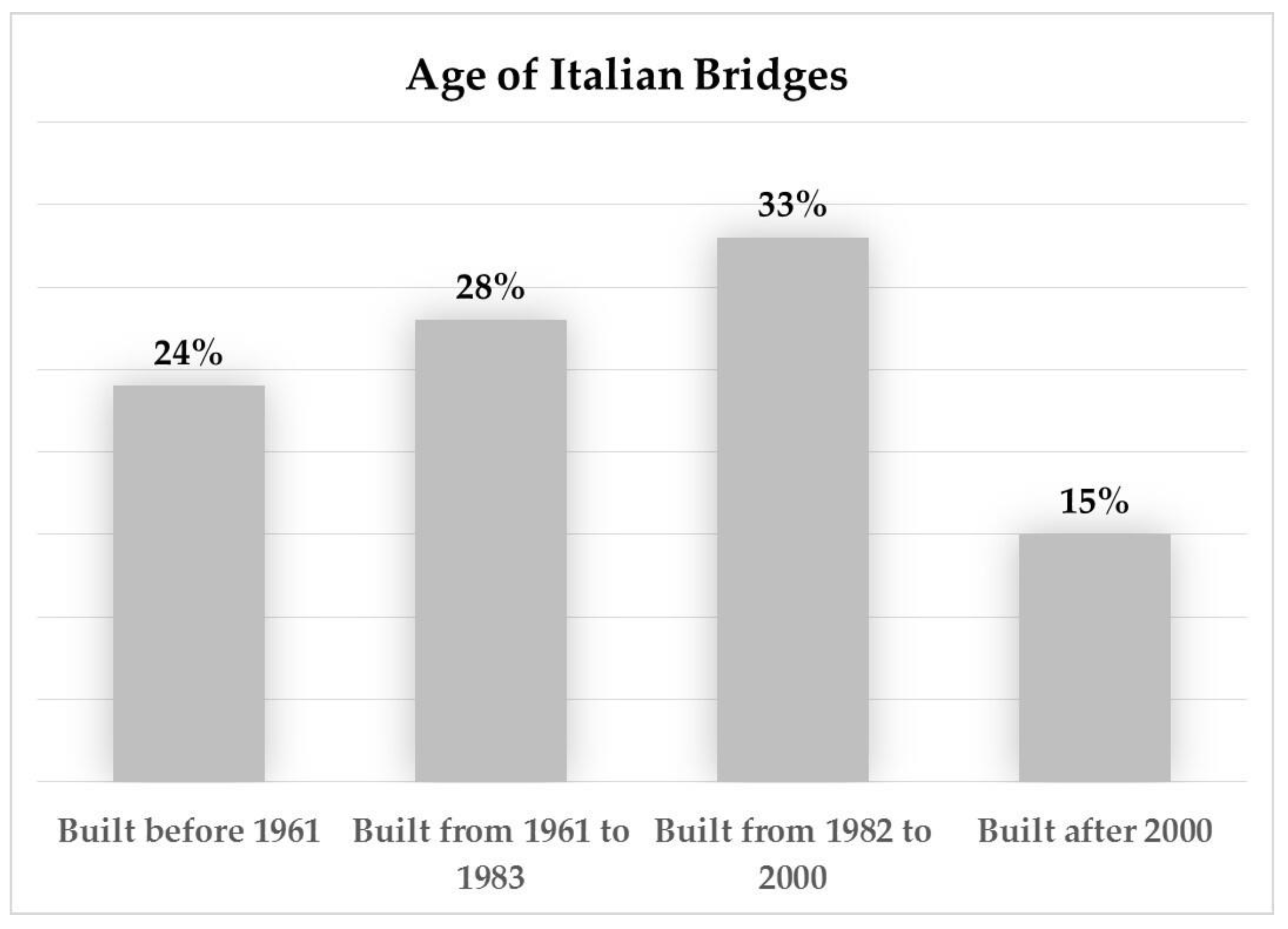
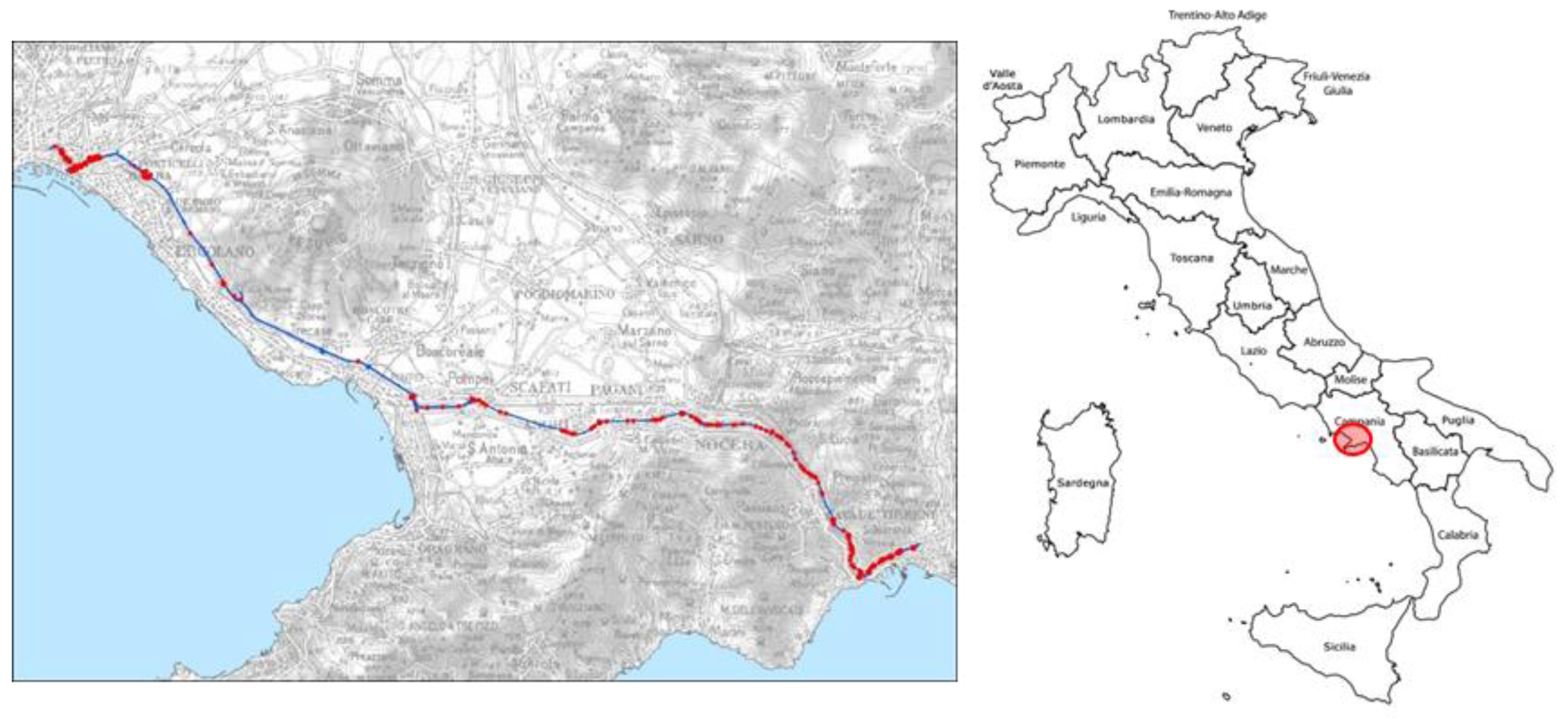

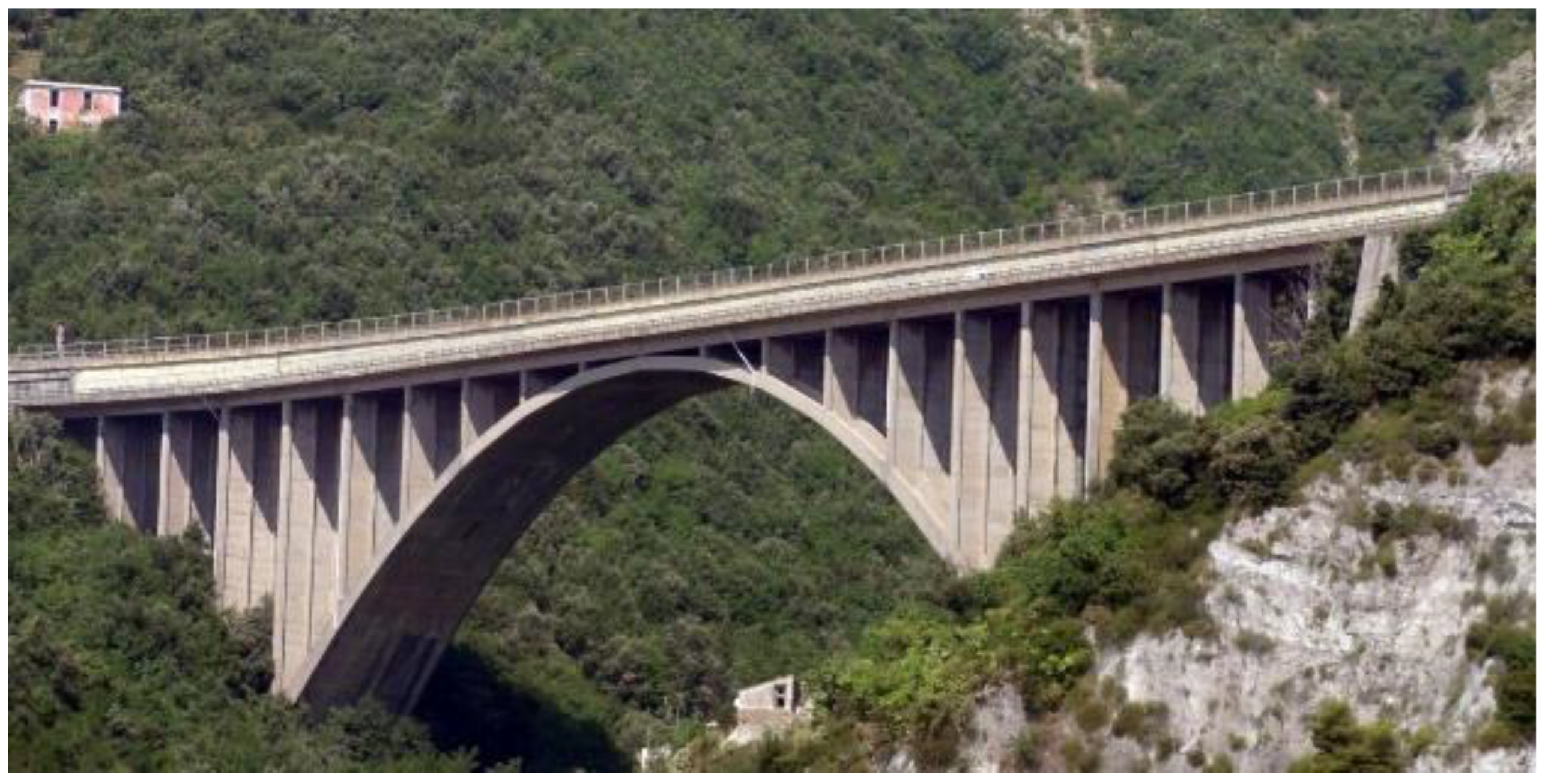
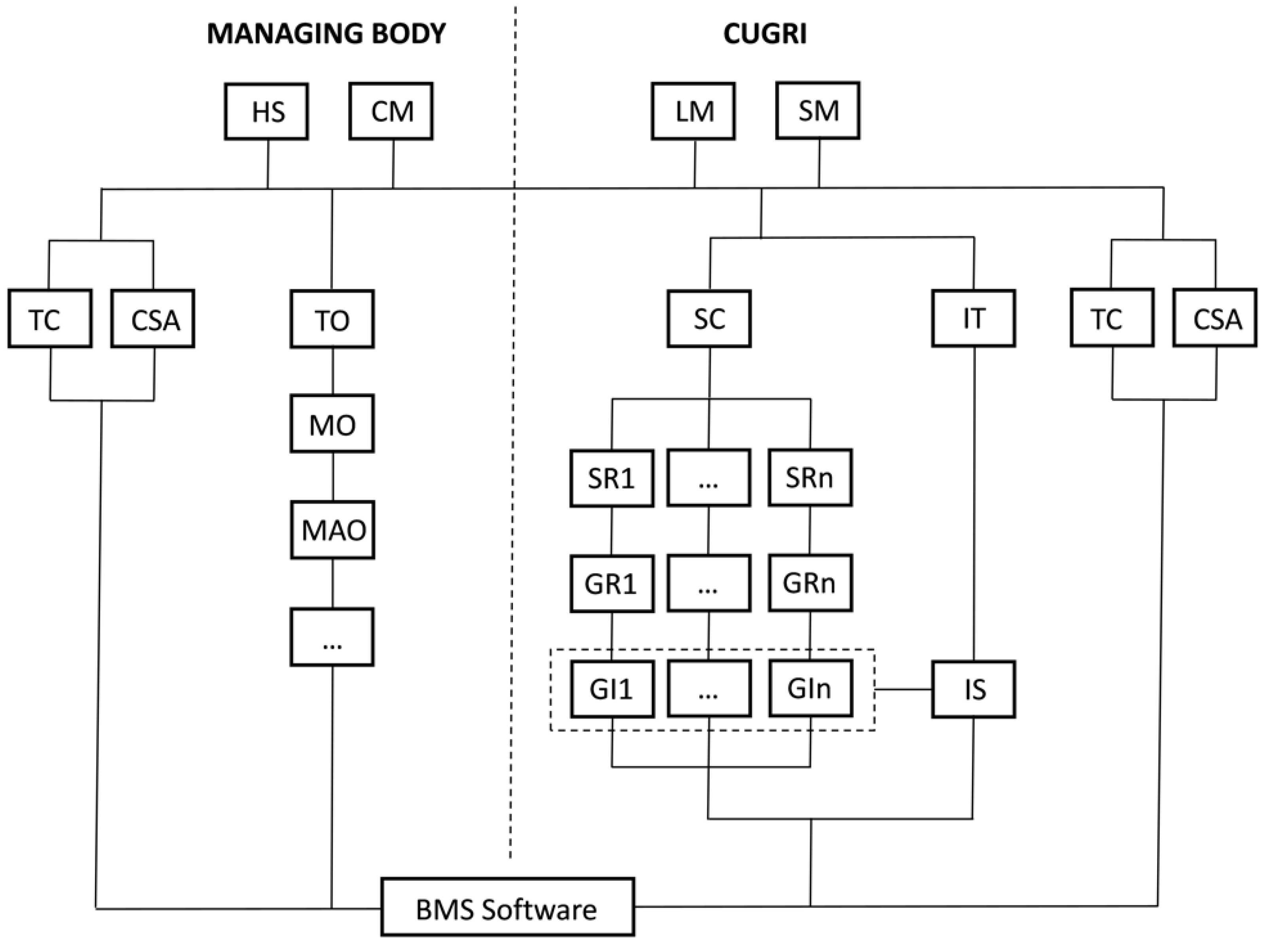

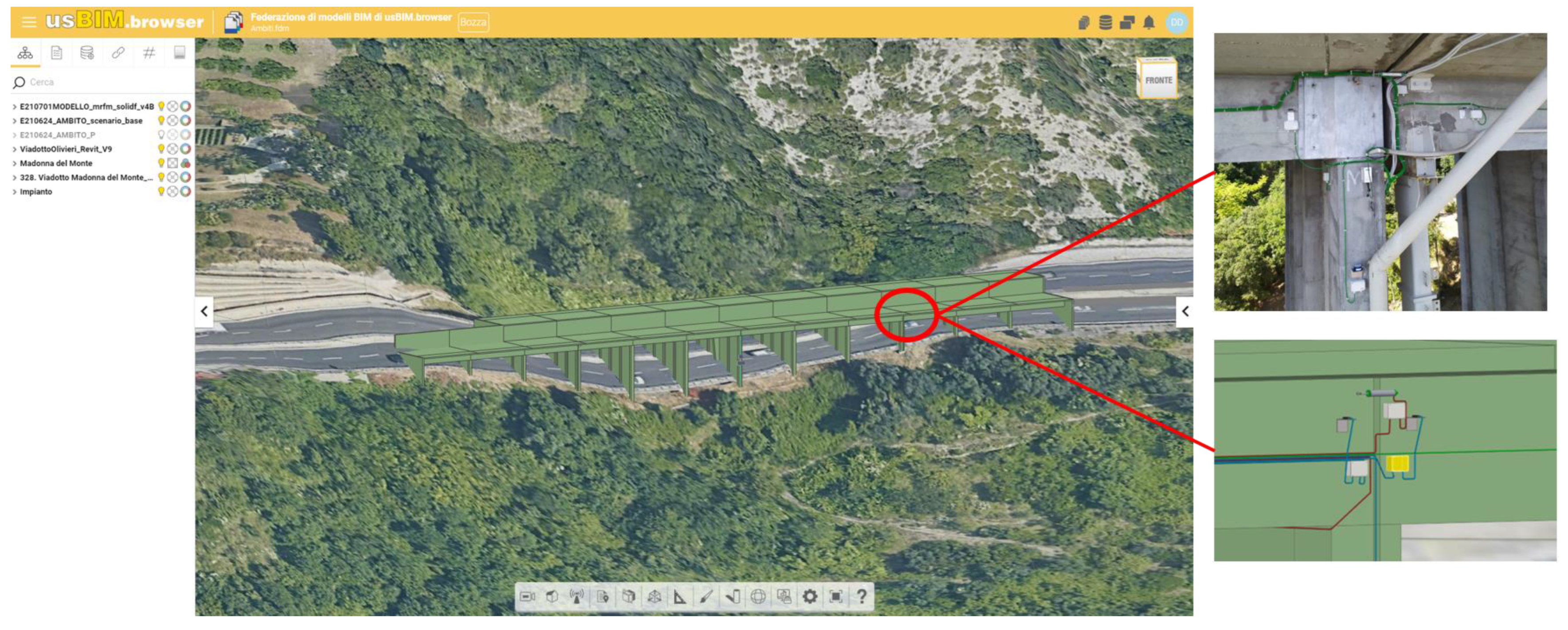
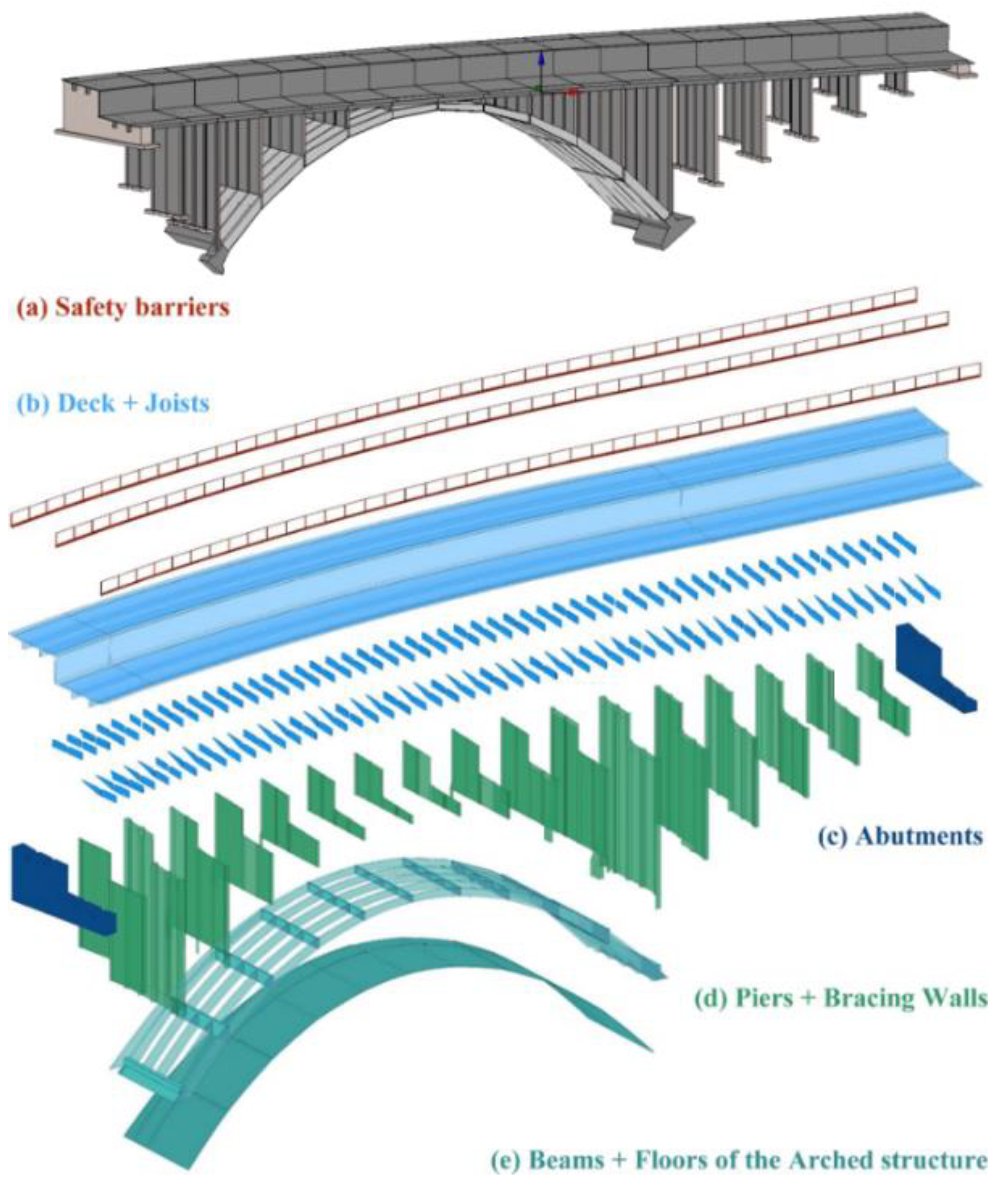
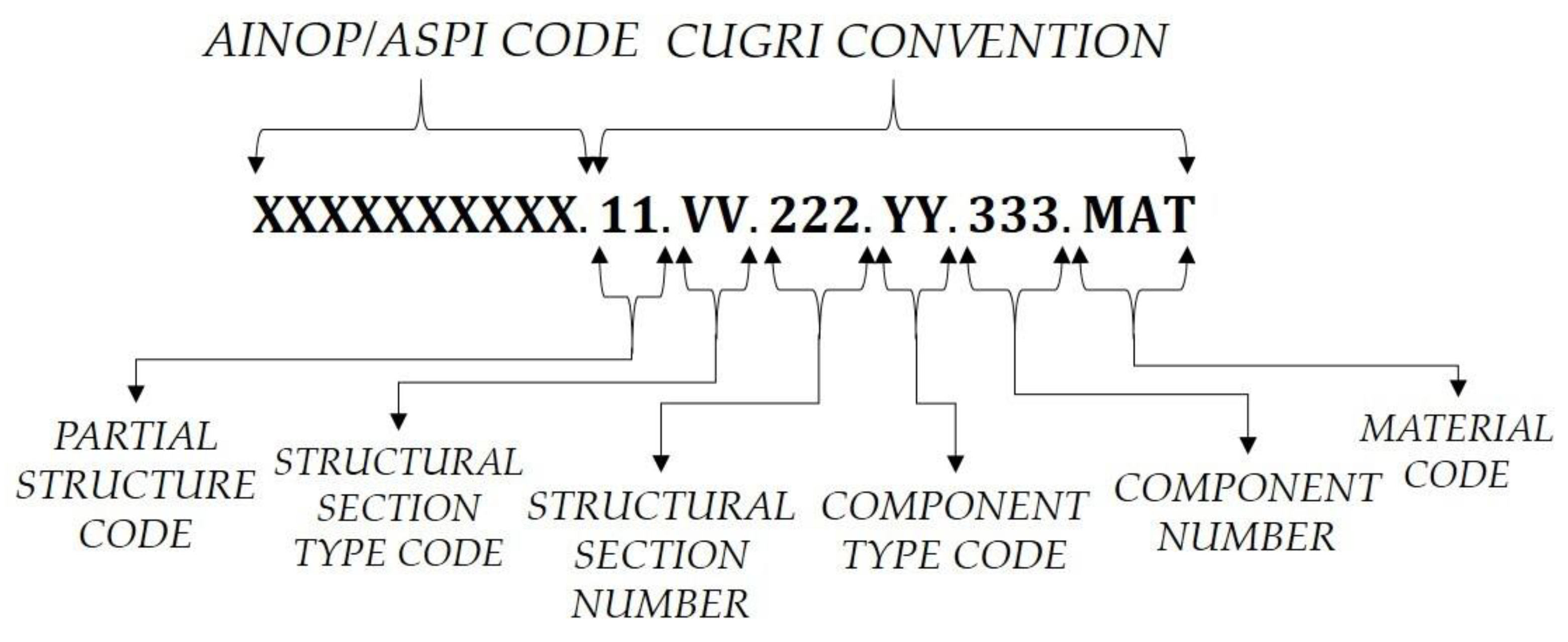
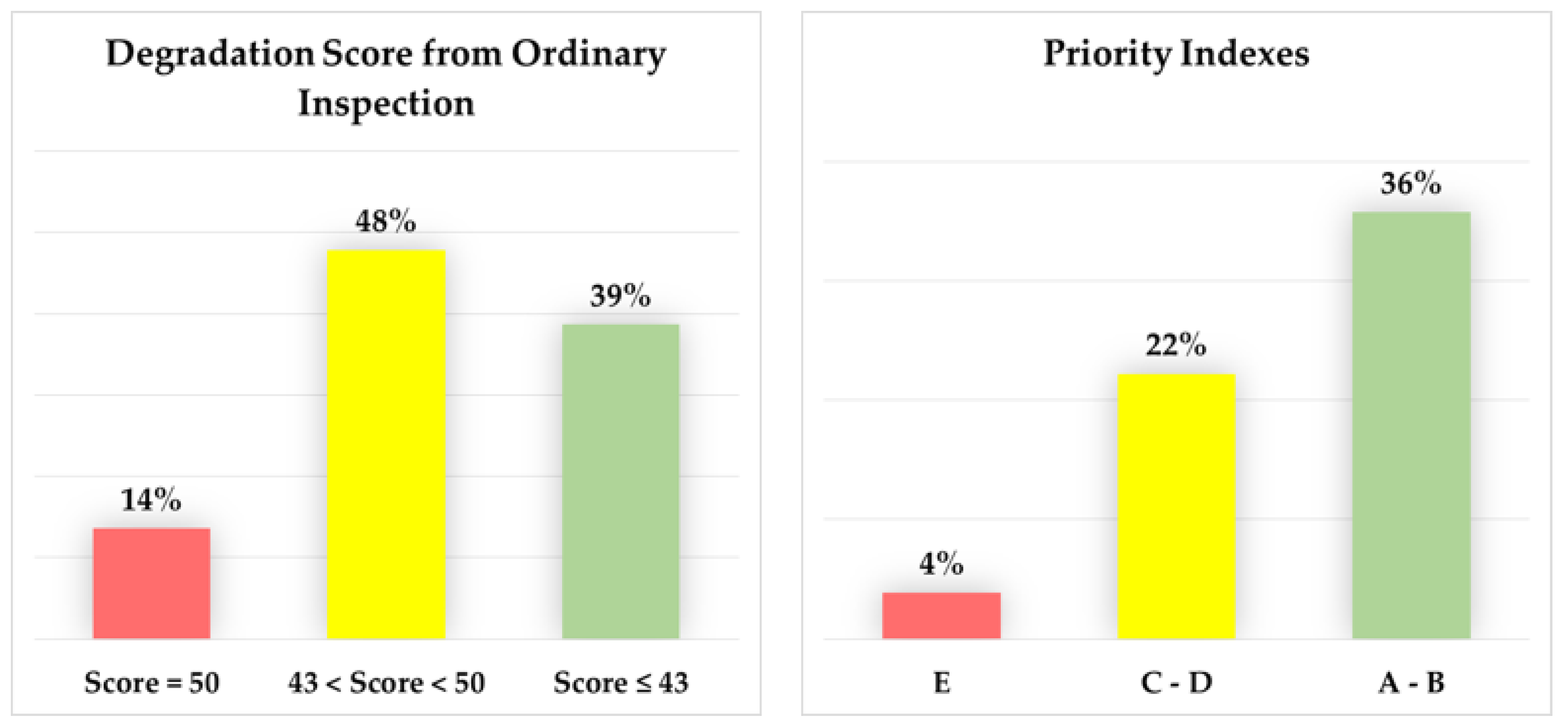

| Macro Groups | Classification | Description | Quantity |
|---|---|---|---|
| 1 | Manholes and Tunnels (L < 6 m) | Manholes | 27 |
| 2 | Bridges, Overpasses and Underpasses (L < 6 m) | Bridge and Underpass | 120 |
| 3 | Bridges and Viaducts (L > 6 m) | Bridge and Viaduct | 207 |
| 4 | Tunnels (L > 6 m) | Tunnels | 14 |
| EXTENT | SCORE | |||||
|---|---|---|---|---|---|---|
| 40–43 | 50 | 60 | ||||
| EL | ER | EL | ER | EL | ER | |
| DP | A | B | C | D | D | E |
| DD | B | C | D | E | E | E |
Disclaimer/Publisher’s Note: The statements, opinions and data contained in all publications are solely those of the individual author(s) and contributor(s) and not of MDPI and/or the editor(s). MDPI and/or the editor(s) disclaim responsibility for any injury to people or property resulting from any ideas, methods, instructions or products referred to in the content. |
© 2023 by the authors. Licensee MDPI, Basel, Switzerland. This article is an open access article distributed under the terms and conditions of the Creative Commons Attribution (CC BY) license (https://creativecommons.org/licenses/by/4.0/).
Share and Cite
Petti, L.; Lupo, C.; De Gaetano, C.M. A Methodological Framework for Bridge Surveillance. Appl. Sci. 2023, 13, 4975. https://doi.org/10.3390/app13084975
Petti L, Lupo C, De Gaetano CM. A Methodological Framework for Bridge Surveillance. Applied Sciences. 2023; 13(8):4975. https://doi.org/10.3390/app13084975
Chicago/Turabian StylePetti, Luigi, Carmine Lupo, and Constanza Maria De Gaetano. 2023. "A Methodological Framework for Bridge Surveillance" Applied Sciences 13, no. 8: 4975. https://doi.org/10.3390/app13084975
APA StylePetti, L., Lupo, C., & De Gaetano, C. M. (2023). A Methodological Framework for Bridge Surveillance. Applied Sciences, 13(8), 4975. https://doi.org/10.3390/app13084975





